定制:传统与融合
哈尔沃·魏德·埃勒夫森,米尔扎·穆叶齐诺维奇/Halvor Weider Ellefsen, Mirza Mujezinovic尚晋 译/Translated by SHANG jin
定制:传统与融合
哈尔沃·魏德·埃勒夫森,米尔扎·穆叶齐诺维奇/Halvor Weider Ellefsen, Mirza Mujezinovic尚晋 译/Translated by SHANG jin
本文研究了在 “自然”视角下的挪威建筑。纵观20世纪,各种各样的环境意识涌现在建成环境和建筑理论中。今天,挪威建筑制造中对自然的运用、阐释和理解的理念在挪威建筑师中几乎已成为一种神话。要从建筑的关系上探讨“自然”的用法和涵义,可以将它解析为自然三相:自然之实、自然之道和自然之象;而这些语汇可以在最近挪威建筑的具体实例上进一步展开。
自然,语境,挪威建筑
“定制”是一次以挪威建筑制造为主题的展览(图1、2)。它没有延续业内当下关于可持续性的讨论。展览的出发点是讨论现代挪威建筑中“自然”(nature)与“天然”(the natural)的作用和联系。建筑图纸和展览照片的选择意在展开当今挪威建筑制造中围绕核心主题、工具和母题的一系列讨论。“定制建筑”的目标不是臆定新的挪威建筑法则,也不是定义一种“挪威建筑”;而是要探索现代挪威建筑文化中的建筑实践形式与建筑理论著述之间的辩证关系。这种二元论可以归结为“制造的传统”(建筑实践)和“传统的制造”(建筑讨论和著述)。在展览中,二者表现为建筑作品的拼贴和被称为“现成品”的装置。现成品以过去70年中理解、探讨和论证建筑的方式——包括2126册书籍、图录、宣传册、杂志和手册在内的165228页收藏品——来揭示传统的制造。“拼贴”则是本文的基础。它的表述框架是20世纪中叶至今建筑对自然的阐释:它展现的是业内借鉴自然、提出理念和设想的轨迹。本文中的作品和文字将重点放在展览主题的若干关键项目和内容上,并转化为杂志出版的形式。
挪威建筑文化的背景
克努特·克努森(Knut Knutsen)是挪威建筑环境意识和生态思想的先驱之一。1961年,他在建筑杂志《建筑艺术》(Byggekunst)发表了文章“以人为中”(Mennesket i Sentrum),成为在资源有限的世界中倡导谦和而有节制的建筑的人本主义生态宣言。这与1960年代他的挪威同行以及国际建筑文化中英雄主义的乌托邦幻想截然相反。早在13年前,他就在波尔多(Portør)建成了自己的夏季住宅(图3)。它的平面和草图甚至被当做挪威因地制宜的景观设计和环境意识的宣言。别墅谦和的尺度在挪威南部多山的海滨景观中显得不同寻常。克努森的建筑棱角分明却又审慎周正。这使他成为20世纪挪威建筑的先锋,歌颂简约与谦逊,并走向它的极致。
从1950年代到1960年代,针对语境的各种环境意识和敏感性问题在建成环境和建筑理论中日渐突出。像克努森的继承者埃利亚森和兰贝特-尼尔森(Eliassen & Lambert-Nielsen)这样的实践建筑师发扬了他的精神,强调建筑与周围景观之间关系的重要性。这一时期最具影响力的新兴建筑师是文克·塞尔默(Wenche Selmer)。在她看来,自己的作品是从两个关系出发的:建筑的环境和建筑的用户。她关注的是现有场地的内在可能和约束,一次形成了一种对场地本身进行创造的手法。在建筑理论上,克里斯蒂安·诺贝格-舒尔茨(Christian Norberg-Schulz)作为《建筑艺术》的编辑,用了10多年来讨论地点、纪念性和传统的问题。他关于现象学的著作为建筑师提供了专业术语,以及从语境出发的建筑实践和制造的理论基础——尽管争议颇多。这就指向了我们的推论——当时出现在建筑中的环境意识,既是一个学科工具,也是一个政治声明:我们今天所讨论的“可持续性”的内容是建筑制造的组成部分,也是在现代性加速全球化的过程中体现地区特殊性和传统的手段。
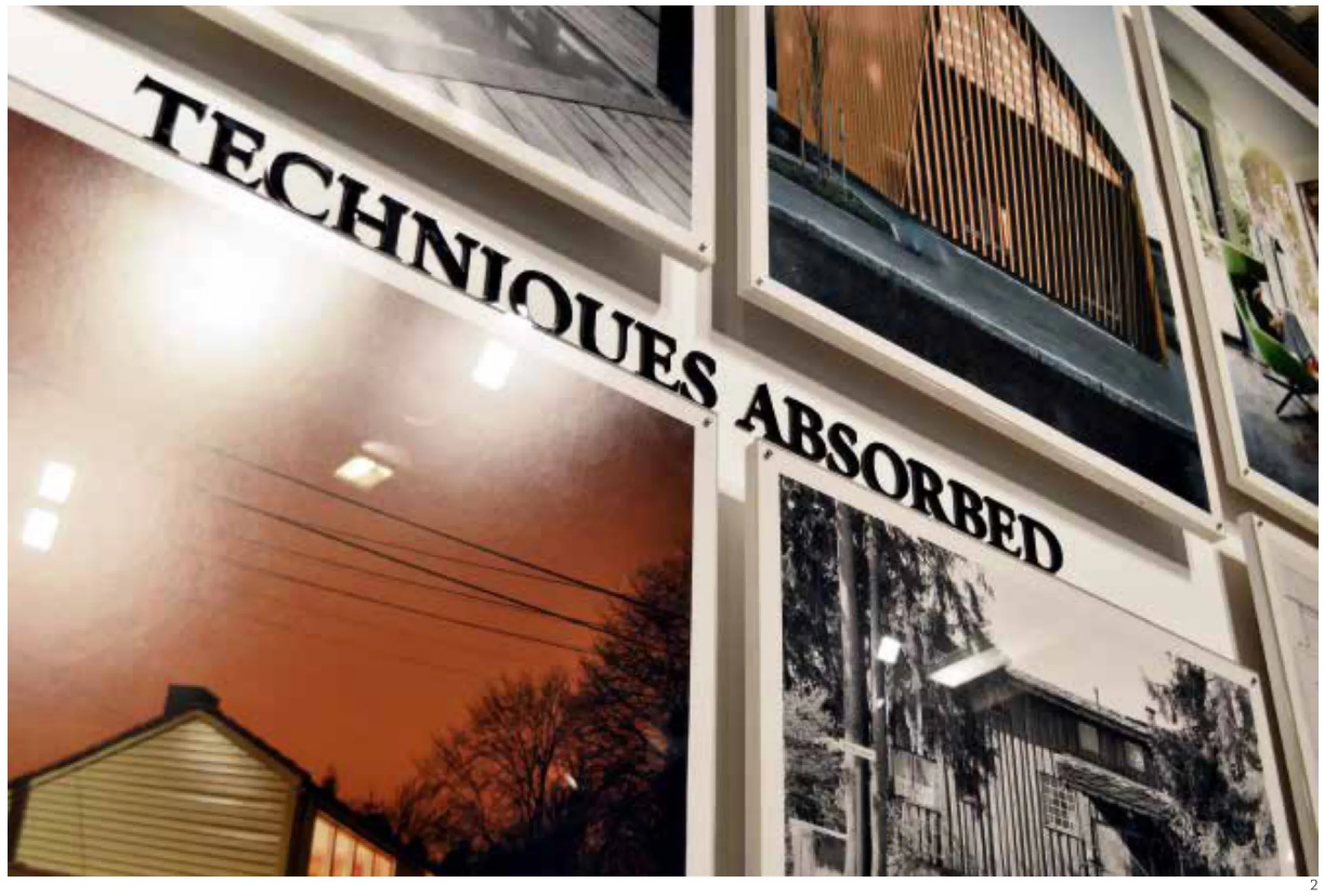
1.2 “定制”展,奥斯陆/Custom Made exhibition Oslo(摄影/Photo: Courtesy of the Custom Made curators)
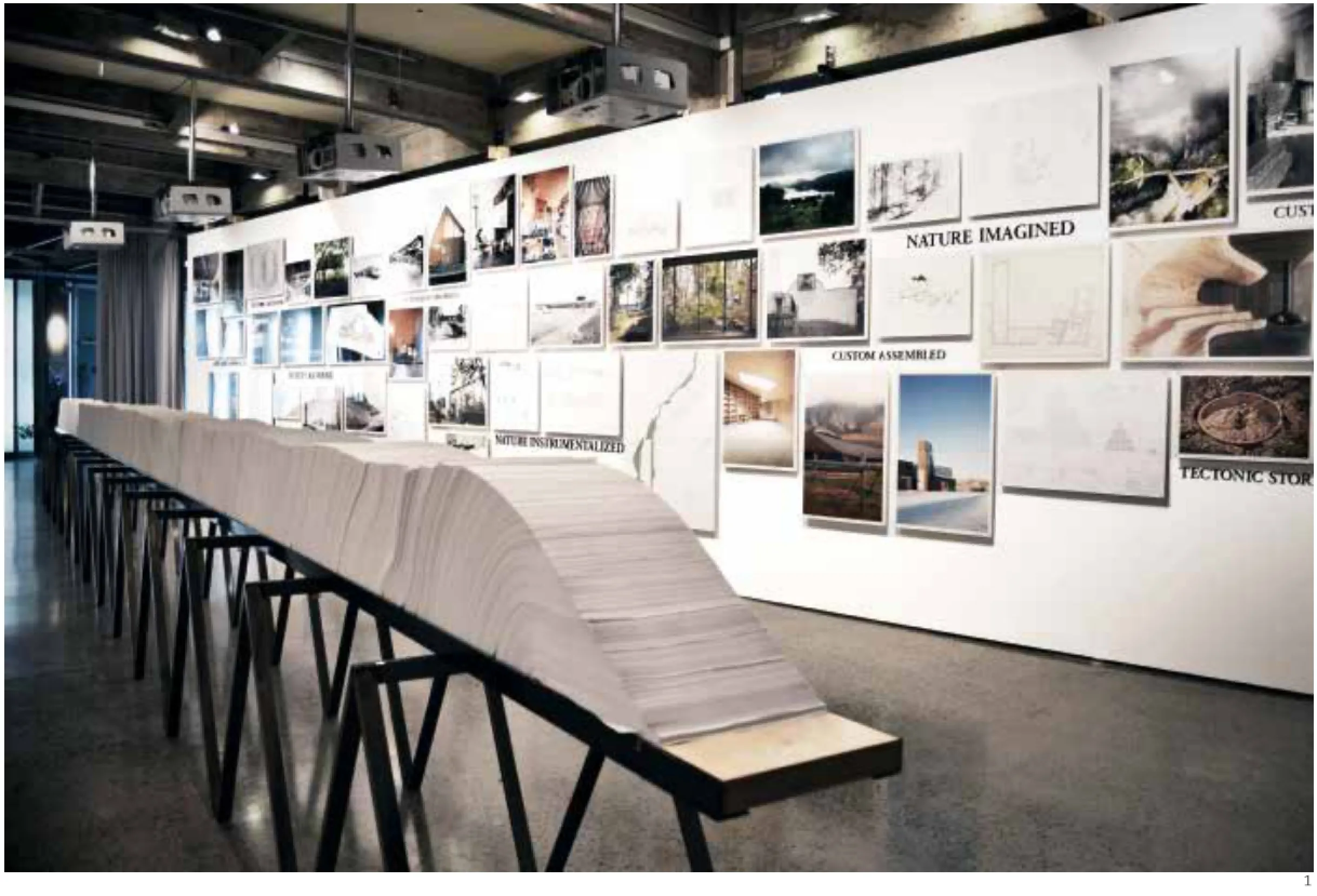
"Custom made" is an exhibition addressing Norwegian architectural production, departing from the current discussions on sustainability within the discipline (Fig. 1, 2). The exhibition's starting point is to explore the role and relevance of "nature" and "the natural" in modern Norwegian architecture.The selection of architectural drawings and photographs of the exhibition is meant to illustrate sets of discussions meandering around central themes, tools and motifs present in Norwegian architectural production. Custom Made aims not towards postulating a new canon of Norwegian architecture, nor does it aspire to identify a definite "Norwegian architecture" as such. Rather, it explores the dialectic between architectural practice forms and architectural discourse in modern Norwegian architecture culture. This dichotomy can be defined as respectively "the tradition of production", meaning architectural practice, and "the production of tradition", referring to architectural debates and discourses. In the exhibition, the two manifest themselves as a collage of architectural works, and an installation called "the readymade".The readymade exposes the production of tradition by referring to how architecture is understood, discussed and legitimized the last seventy years through a 165,228 page long collection containing 2126 books, catalogues, pamphlets, magazines and manuals. "e collage" is the basis on which this article is written. Its narrative is structured around interpretations of nature in architecture from the mid twentieth century until today: It unfolds trajectories of nature references, ideals and ideas within the discipline.The works, and texts presented here elaborate on some key projects and aspects of the exhibition's theme, translated in to a magazine format.
The Backdrop of Norwegian Architecture Culture
An early advocate for environmental awareness and ecological thinking in Norwegian architecture was Knut Knutsen, that in his essay "Mennesket i Sentrum" ("Man as Midpoint"), published in architectural magazine "Byggekunst" in 1961, provided a humanist, ecological manifesto for a modest and restrained architecture in a world of limited resources, contrary to the imaginings of heroic utopias projected by many of his Norwegian colleagues and by the international architecture culture of the 1960s. irteen years earlier, he had completed his own summerhouse at Portør, whose plans and sketches became somewhat of a manifesto for landscape adaption and environment-conscious design in Norway (Fig. 3). The house's modest dimensions are contrasted by its unconventionaladaption to the rocky coastal landscape of southern Norway. Knutsen's edgy, although prudent, architecture locates him within the forefront of Norwegian architecture in the twentieth century, being an avant-garde celebrating (and subsequently exhausting) the frugal and the humble.
1960年代末,建筑业日趋政治化。环境主义与建筑的关系也愈发重要,而自然景观意识仍是北欧建筑的特征。在挪威,斯韦勒·费恩(Sverre Fehn)已成为面向国际的一代建筑师的代表——他们都以复杂的个人阐释推进现代主义的理念。费恩作为建筑师的毕生成就源自可数的几个项目,而这使他跻身20世纪欧洲大师的行列。其中包括威尼斯的北欧馆(图4):它将纪念性与因地制宜的场地设计结合起来,使现有的树木与建筑融为一体。另一个名气略小的项目是奥斯陆的斯科达伦(Skaadalen)听障学校。这座砖与混凝土的建筑将斯韦勒·费恩建筑中最具代表性的质朴与节制体现得淋漓尽致。尽管斯韦勒·费恩是挪威无可争议的最负盛名的建筑师,但与他同时代还有很多值得一提的大师。阿雷·韦斯特利德(Are Vesterlid)就是其中一位。他独立完成或与Arkitim事务所合作的小尺度住宅,对于木材和施工工艺有一种敏感的实用性。瑟吕姆(Sørum)农场项目(图5)也是一个木结构扩建与旧农房结合的典范。
而更具商业性的工作室被认为继承了特殊的“北欧”建筑手法。在挪威,大名鼎鼎的建筑师尼尔斯·托尔普(Nils Torp)通过斯德哥尔摩的北欧航空公司项目(图6),以及后来的希斯罗英国航空公司总部项目,对办公楼建筑进行了“再创造”。这两座建筑都有一套基础设施体系作为大型公共空间使用,而这在后来被提炼为“北欧办公楼模式”。尽管与自然的联系较少,这些建筑把大型办公建筑的尺度分解为可控的体量,让室内外空间相互交融。不过,从1980年代中期开始,随着技术和生态建筑的发展,出现了新一代建筑师,对挪威建筑法则进行反思和重构。他们的作品展现出处理自然和景观的赋有活力的手法,强调业内特定的观点、方法和技术,并在1990年代形成了新的专业路线。一个更早的例子是延森与斯科温建筑师事务所(Jensen & Skodvin Arkitekter)的利亚桑登(Liasanden)道路观景点(图7)。它表达概念的手法是用简单的技术和廉价的材料实现宏大而克制的设计。最近, Code建筑师事务所的通厄内塞特(Tungeneset)观景点项目(图8)采用了相似的理念,通过微微抬高的线性桥体强化了景观的效果。业内的变化在这一时期的建筑中也表现得非常明显:在阿斯金姆和兰托事务所(Askim & Lantto)的项目费特松兰瑟(Fetsund Lenser,图9)的场地平面中,景观不但是建筑的组成部分,也是强化和展现建筑自身的工具。在雷于尔夫·拉姆斯塔(Reiulf Ramstad)最近的特罗斯蒂根国家旅游线路项目中,我们看到了相似的情况,项目场地平面表现出,现有的景观和新增的建筑成为不可分割的整体。
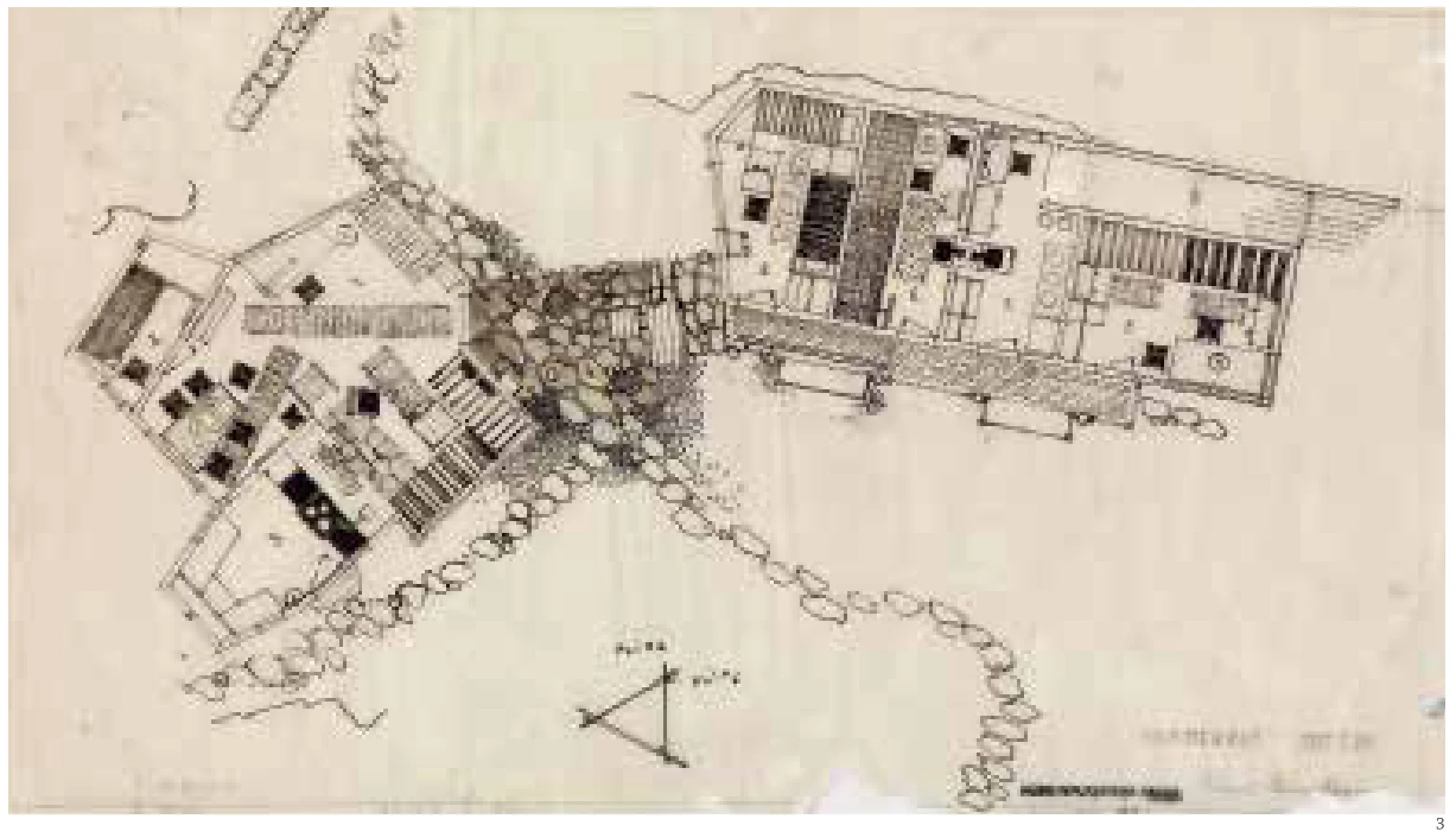
3 波尔多夏屋首层平面,1949年,克努特·克努森/Portør Summer House, 1949, Knut Knutsen, ground-foor plan
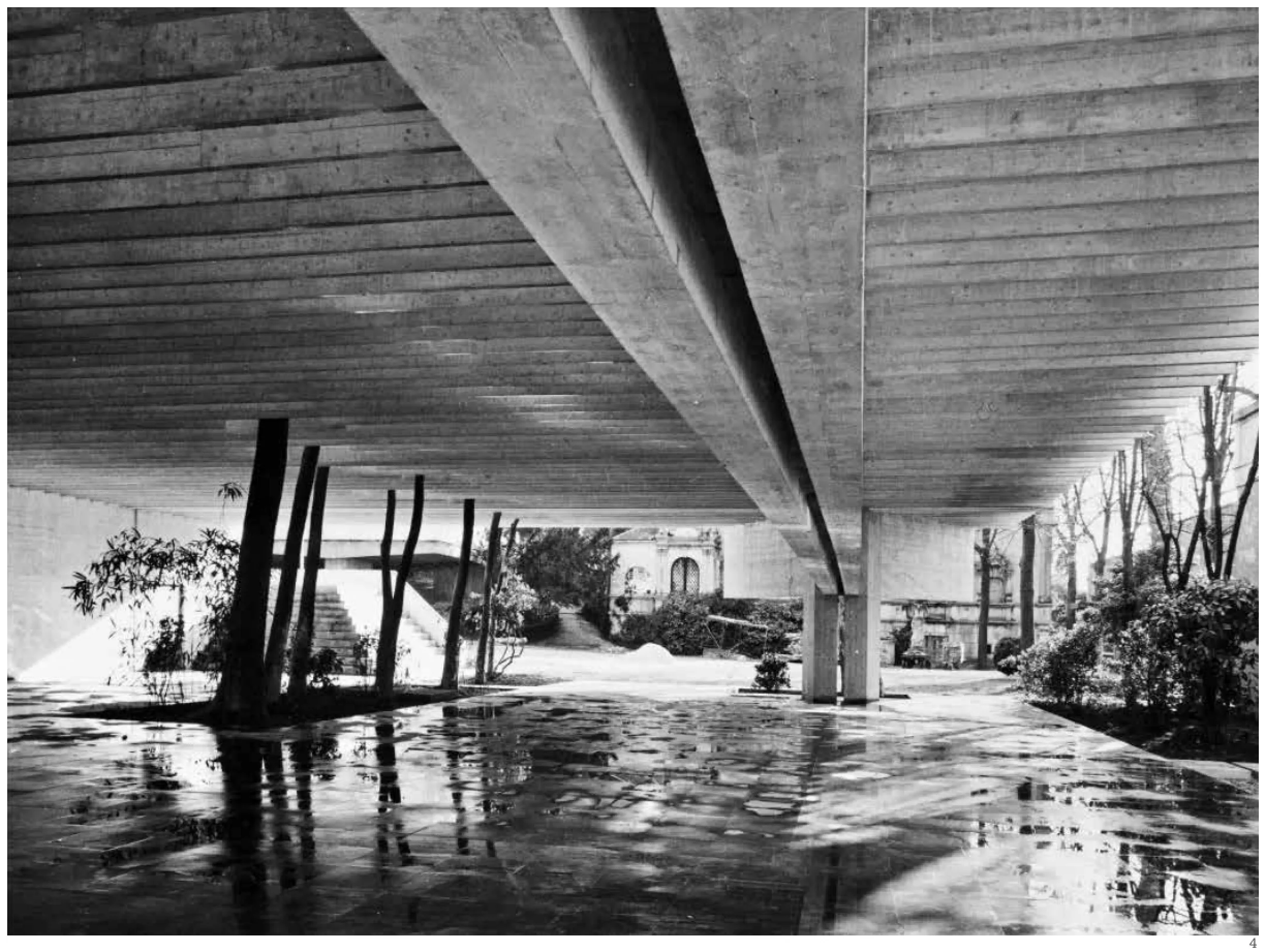
4 威尼斯馆,1962年,斯韦勒·费恩/venice Pavilion, 1962, Sverre Fehn(摄影/Photo: Teigens Fotoatelier)
Through the 1950s and 1960s, forms of environmental awareness and sensitivity towards context manifested themselves both through the built environment and architectural theory. Practicing architects like the Knutsen protégés Eliassen & Lambert-Nielsen evolved the legacy of Knutsen, stressing the importance of a building's relation to its surrounding landscape. Among the most influential emerging architects of this era is Wenche Selmer, whose work was, according to herself, based on two relationships: The building's surroundings and the building's users. Her focus on a given site's inherent potentials and constraints constitute an approach that could be read as an invention of the site itself. Within architectural theory, Christian Norberg-Schulz addressed the issues of place, monumentality and tradition for over a decade as the editor of "Byggekunst". His works on phenomenology provided architects with both a terminology and, if though disputed, theoretical basis for context-driven architectural practice and production. This leads to our claim that the environmental awareness found in architecture at the time was a disciplinary instrument as much as a political statement: What we today defne within "sustainability" discussions was an integrated aspect of architectural production, as well as a tool to articulate regional specificity and tradition in an increasingly globalized modernity.
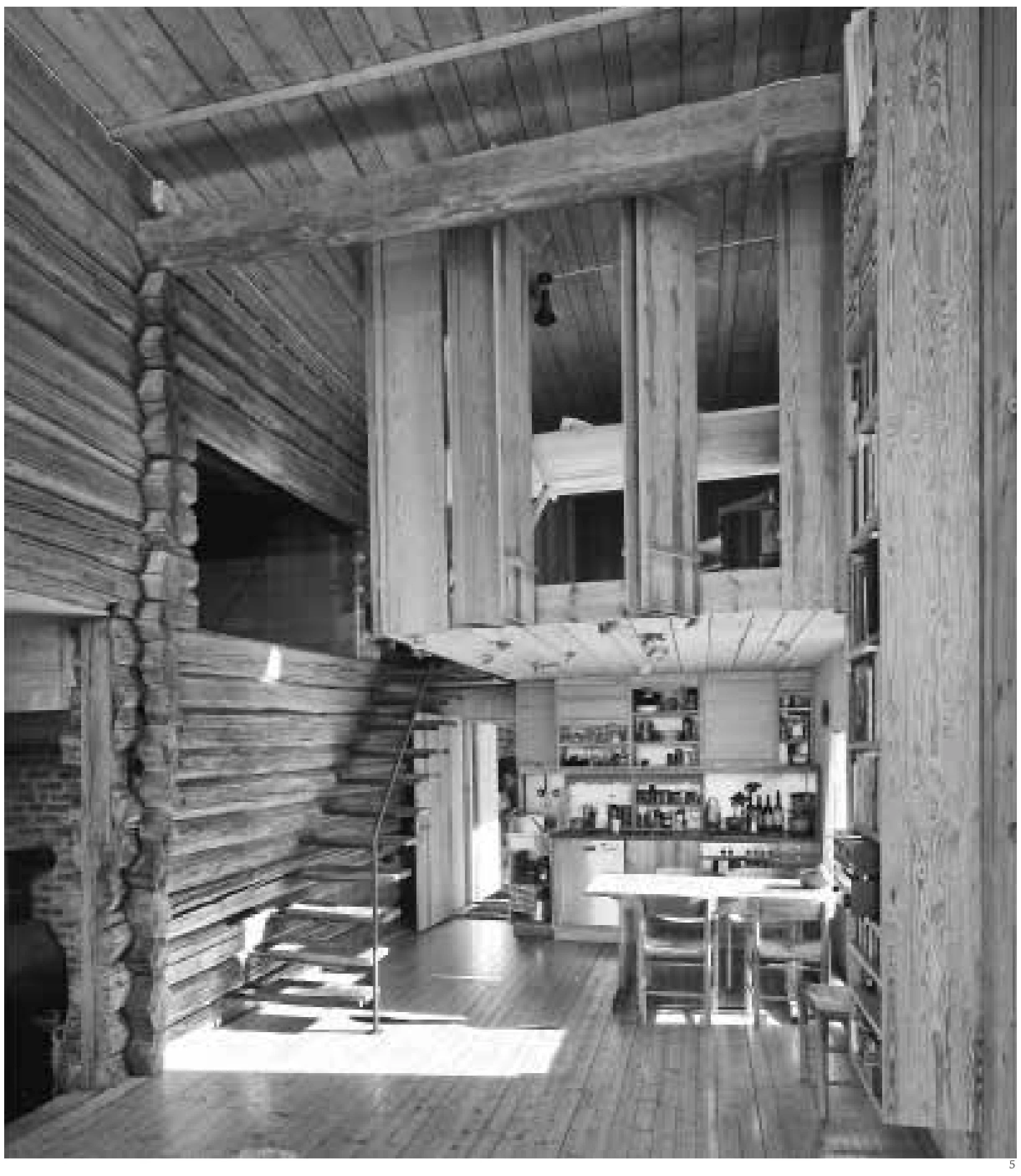
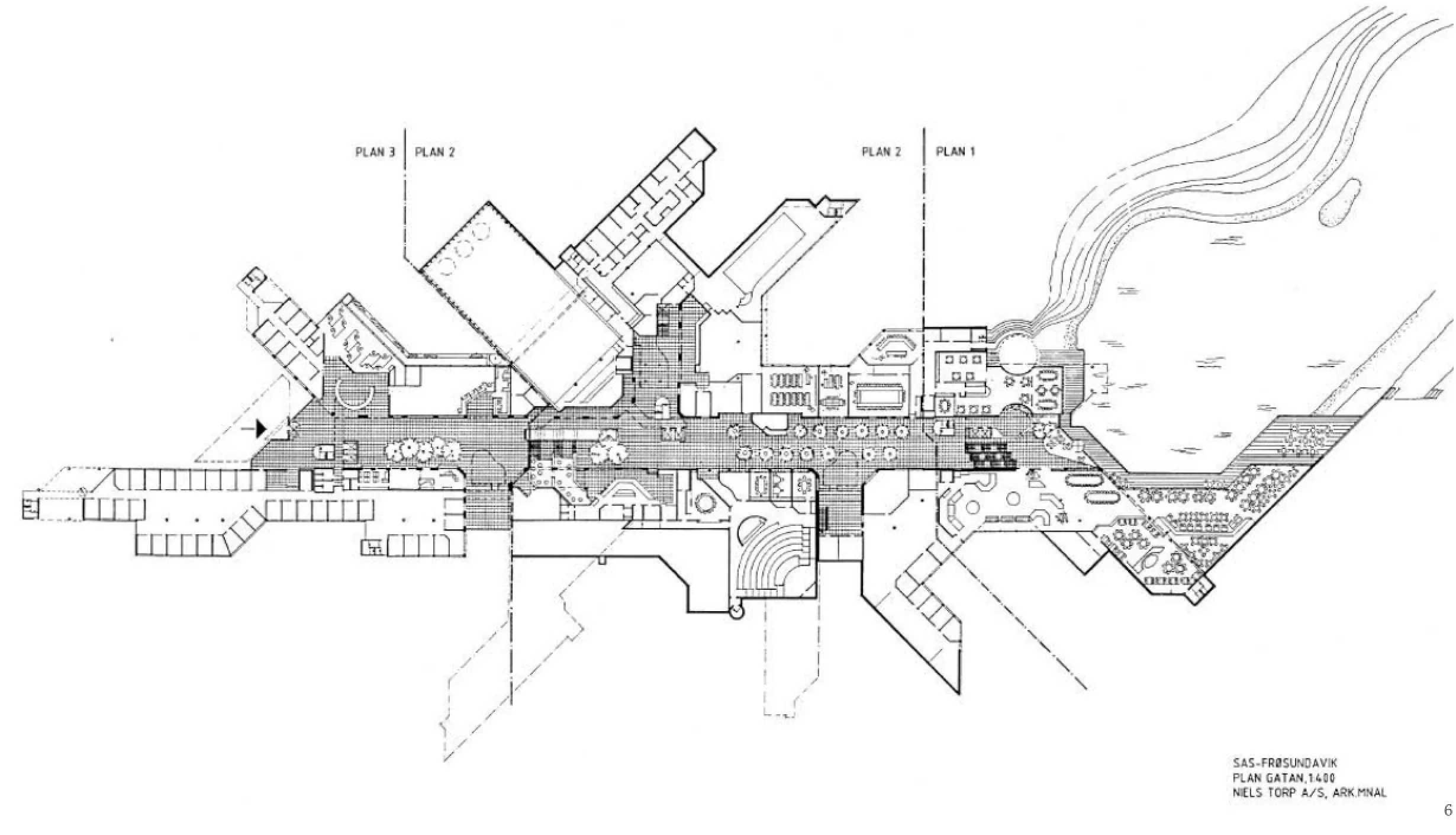
5 瑟吕姆农场,2003年,阿雷·韦斯特利德/Sørum Atelier, 2003, Are vesterlid(摄影/Photo: Rickard Riesenfeld)6 斯堪的纳维亚航空公司总部首层平面,1987年,尼尔斯·托尔普/Scandinavian Airlines Headquarters, 1987, Nils Torp, ground foor plan
Parallel to environmentalism's growing pertinence in the gradually more politicized discipline of the late 1960s, awareness of nature landscapes continued to define Nordic architecture. In Norway, Sverre Fehn had come to represent an international-orientated generation of architects that evolved modernist credos through complex, personal interpretations. Fehn's lifetime achievement as an architect resulted in a handful of projects that placed him among the great European masters of the 20thcentury. Among these is the Nordic pavilion in venice (Fig. 4), that combines monumentality with a subtle adaption to site, underlined by the integration of existing trees into the building. A somewhat less celebrated project is Skaadalen School for the hearing impaired in Oslo. is brick and concrete building exposes the earthy modest and controlled approach representative for Sverre Fehn's architectural oeuvre. Although Sverre Fehn is undisputedly Norway's most cherished architect, there are also other masters of his era worth mentioning. Among these is Are vesterlid, whose small-scale residential buildings, executed alone or in cooperation with office Arkitim, possess a sensitive pragmatism to wood-based materials and construction techniques. The project "Farm at Sørum" (Fig. 5) also exemplifes how an added wood structure merges with the existing timber construction of the old farm building.
Also more commercially orientated ofces have been said to sustain a specifc "Nordic" approach to architecture. In Norway, the influential and highly prolific architect Nils Torp was said to "re-invent" the ofce building with his project for Scandinavian Airlines outside Stockholm (Fig. 6), and later, British Airways headquarters outside Heathrow. Both buildings feature a hierarchy of infrastructures that functions as large common spaces, a diagramthat later has been labeled "the Scandinavian office model". Though less associated with nature, these buildings break down the scale of large ofce complexes in to manageable volumes challenging the relation between indoor and outdoor spaces. From the mid-1980s however, and parallel to the evolution of a technological, ecological architecture, a new generation of architects emerged that revisited and re-conceptualized the Norwegian architectural cannon. Their work represented a rejuvenated approach to nature and landscape, accentuating specific discussions, approaches and techniques within the discipline that would establish new disciplinary agendas throughout the 1990s. An early example is jensen & Skodvin Architects' "Liasanden road rest stop"(Fig. 7) that displayed a conceptual approach to the landscape through a grand and underplayed design using simple techniques and inexpensive materials. Recently, Code Arkitektur's "viewpoint Tungeneset" (Fig. 8) used a similar idea of amplifying the presence of landscape through a slightly elevated linear bridge structure. Changes within the discipline also became apparent in architectural representations of the era: In the situation plan for Askim & Lantto's project "Fetsund Lenser" (Fig. 9)the landscape was an integral part of its architecture, and utilized as
a tool to strengthen and legitimize the building itself. In Reiulf Ramstad's recent "National tourist route Trollstigen" we see a similar condition, where the existing landscape and the architectural intervention become inseparable entities conveyed by the project's situation plan.

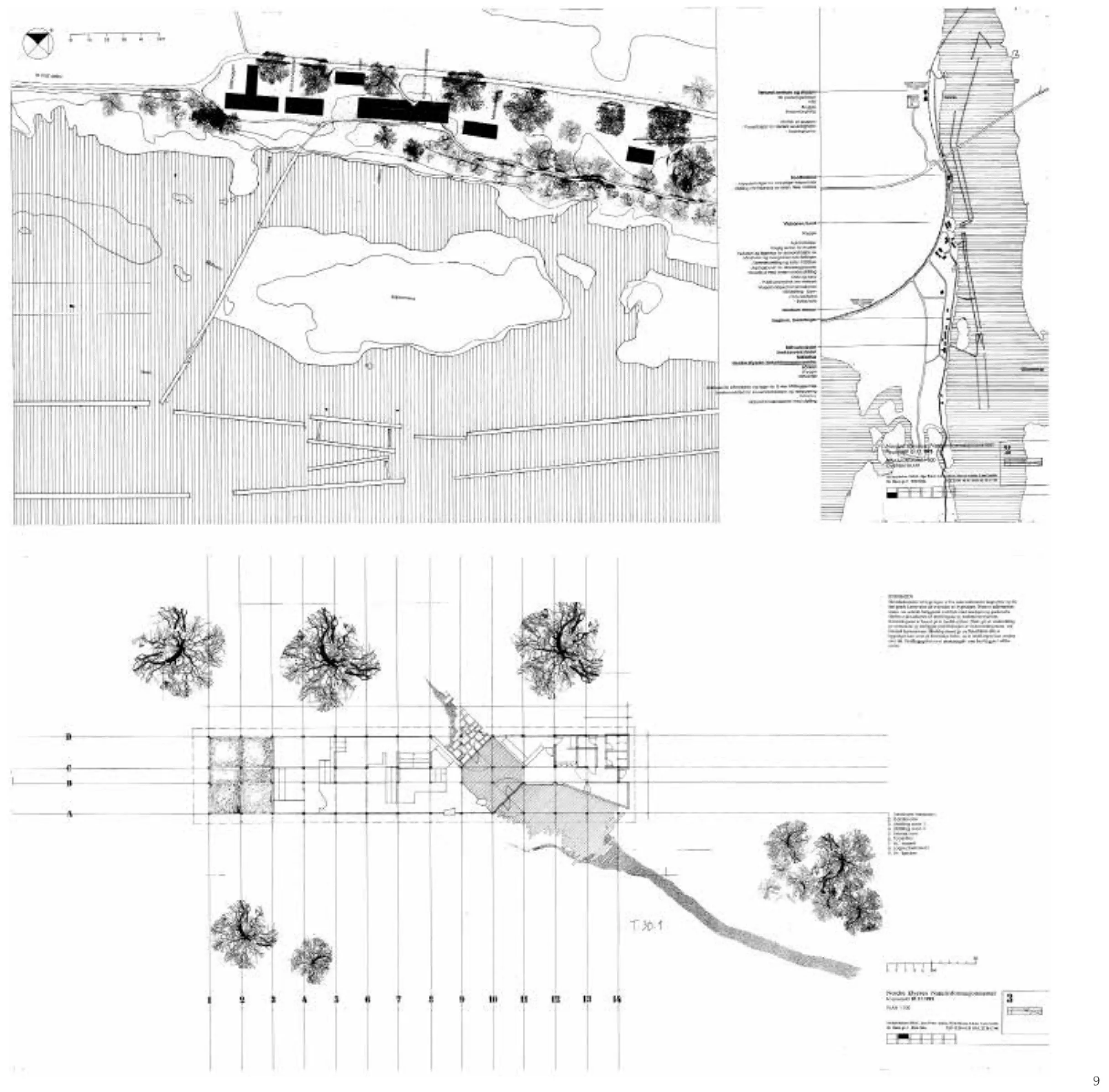
8 通厄内塞特观景点,Code建筑事务所/Tungeneset tourist stop, Code: Arkitektur AS(摄影/Photo: diephotodesigner. de.jpg)9 费特兰松瑟场地平面,阿斯金姆和兰托事务所/Fetsund Lenser, Askim & Lantto, site plan
7 利亚桑登旅游线路项目,1998年,延森与斯科温建筑师事务所/Liasanden Tourist Road Project, 1998, jensen & Skodvin Arkitekter AS(摄影/Photo: Courtesy of jensen & Skodvin Arkitekter AS)
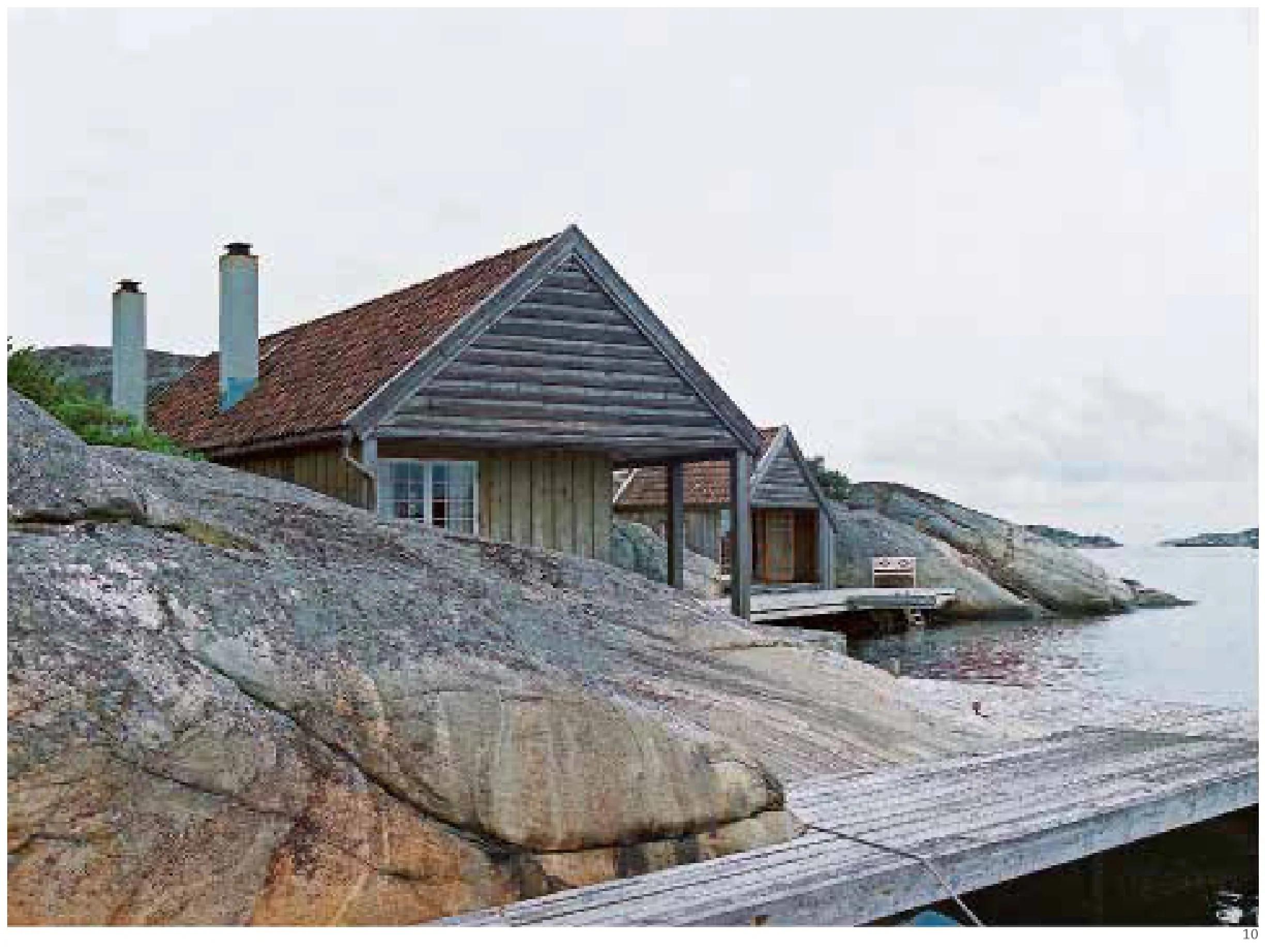
10 克斯特格莱德夏屋,1965年,文克·塞尔默/Kisteglad Summer House, 1965, Wenche Selmer(摄影/Photo: Frode Larsen)
自然三相
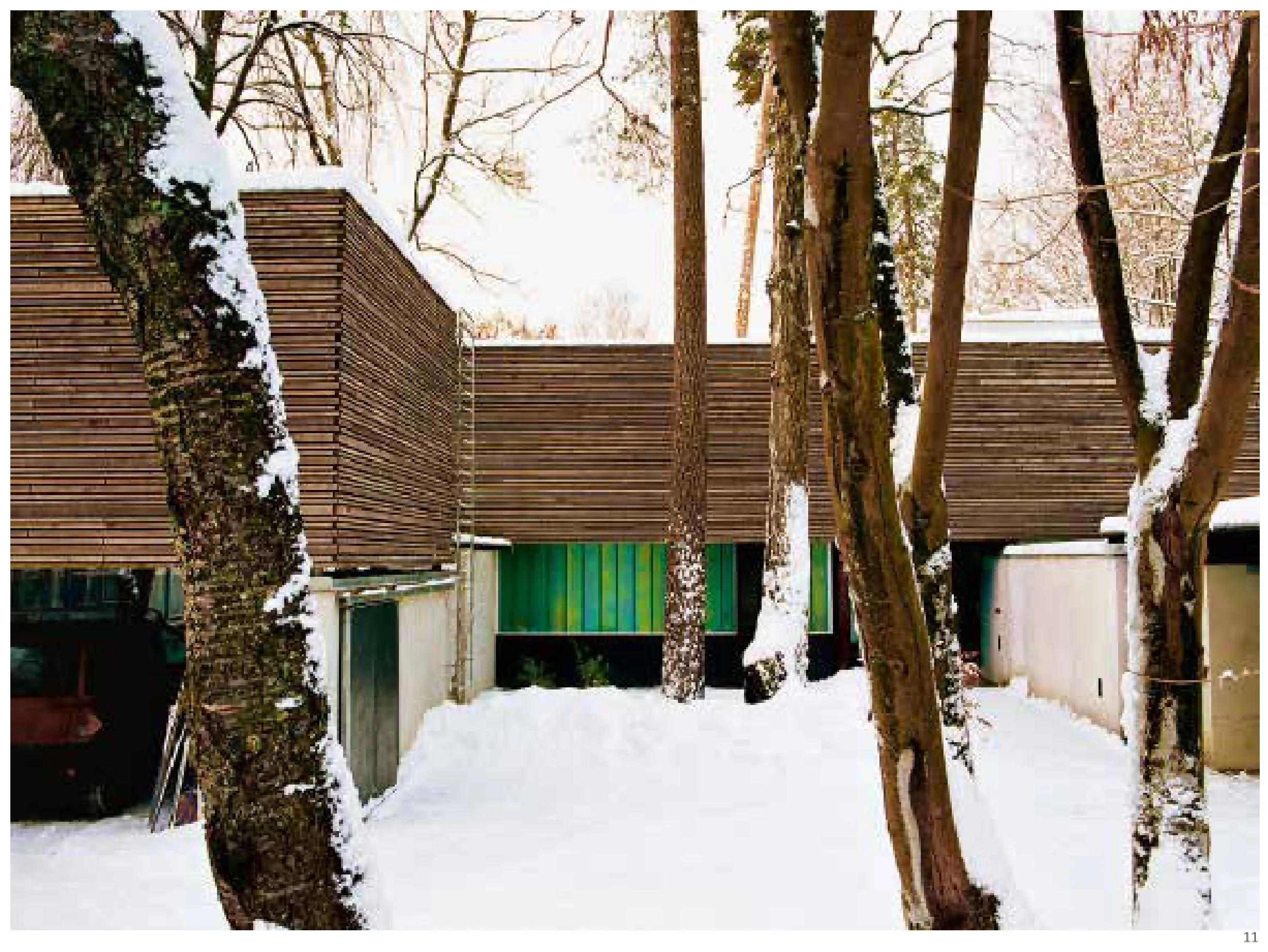
11 富鲁隆德别墅,1988年,伦–哈格姆建筑事务所/villa Furulund, 1988, Lund & Hagem Arkitekter AS(摄影/Photo: Nils vik)
挪威建筑制造中对自然的运用、阐释和理解在这个国家的建筑师中有一种神秘的韵味。不过,作为手法,它可以“分解”为三大主题:自然之实、自然之道和自然之象。第一大主题“自然之实”将自然视为给建筑制造直接带来灵感的空间条件,其最突出的表现是建筑师处理地形和气候的方法。凭借简单的工具和技术,自然就成为可以接受、甚至是强化的空间实体。这表达出一种因地制宜的意愿,而它源于审慎的态度和建筑理念上的简约。倡导这种态度的不仅有文克·塞尔默的项目(图10),还有同时代的伦与哈格姆建筑师事务所(Lund &Hagem Arkitekter)。他们对富鲁隆德 (Furulund)别墅(图11)的组织就是从场地中植物的布局出发的,将松树作为建筑表达的概念工具。

12 埃尔夫夏屋,2002年,莉丝贝特·丰克,托马斯·麦奎兰/ Erve Summer House, 2002, Lisbeth Funck, omas McQuillan(摄影/Photo: Ivan Brodey)
Three Themes of Nature
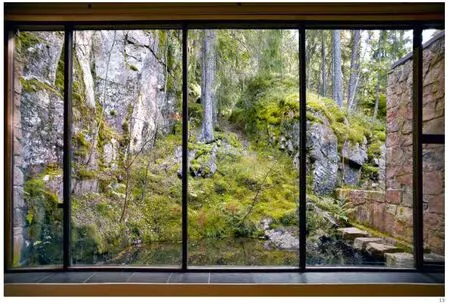
13 霍尔姆斯布画廊,1973年,比亚特·莫尔/Holsmbu Gallery, 1973, Bjart Mohr(摄影/Photo: james Bengtson)
The utilization, interpretation and understanding of nature as concept within Norwegian architectural production claim an almost mythical status among the country's practicing architects. As approach however, it can be "decrypted" in to three main themes: Nature as found, nature instrumentalized and nature imagined. The first theme, "nature as found", deals with nature as a physical constraint directly informing architectural production, represented most evidently by how architects approach topography and climate: By means of simple tools and techniques, nature is seen as a physicality to be accepted and even accentuated. is exposes a will for contextual adaptation rooted in frugality both in terms of prudence, but also as ideological approach to architecture. Exponents of such attitudes are projects by Wenche Selmer (Fig. 10), but also contemporaries like Lund Hagem Arkitekter: Their organization of "villa Furulund" (Fig. 11) is based on the mapping of vegetation found on the plot, integrating its pine trees as a conceptual tool in the articulation of the building.
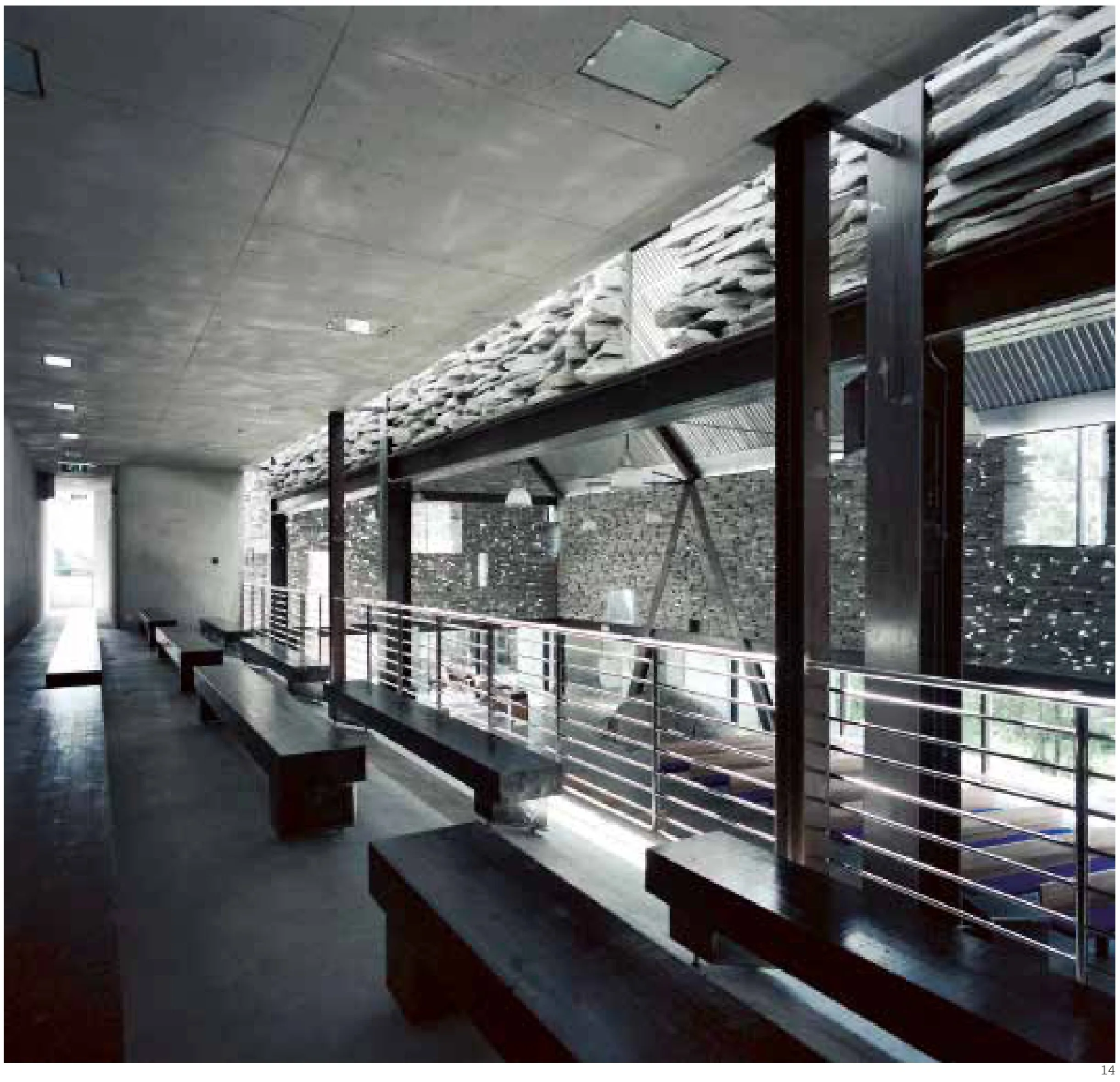
14 莫滕斯鲁德教堂,2002年,延森与斯科温建筑师事务所/ Mortensrud Church, 2002, jensen & Skodvin Arkitekter AS(摄影/Photo: Courtesy of jensen and Skodvin Arkitekter)
The second theme,"nature instrumentalized", aims to describe projects where nature is utilized to validate, legitimize or stage architecture. Here, nature becomes the silver screen on which architectural illusions are projected. Autonomous buildings become strengthened by the rhetoricand narrative that landscapes can provide. An evident example is Lisbeth Funck and Thomas McQuillan's "Erve Summerhouse" (Fig. 12); simple and small in its tree-clad articulated containershape, but voluminous in its scope through localization and orientation. Another prominent project in this category is Bjart Mohr's "Holmsbu Gallery" (Fig. 13)from 1973, where large windows frame the forest understory as motif within the gallery. jensen & Skodvin Architects continuously explore the relation between the interior and the exterior. In Mortensrud Church (Fig. 14), the integration of bedrock as a literal altar within a religious building accentuates the transition from Wenche Selmer's perceived humbleness to an architectural scenography articulated in Norwegian glacier-polished stone. In jensen & Skodvin's most recent project "Cabin Storfjord" the dialectic between inside and outside mediated by the exposed bedrock is obliterated altogether: The former transcendent nature here becomes immanent with architecture. The resulting building is monumental, yet utilizing every potential provided by its hillside surroundings in its design.

15 “誊写自然”,2012年,奥斯陆工作室/Transcribed Nature Installation, 2012, Atelier Oslo AS
The third theme "Nature Imagined" projects nature as a conceptual platform from which architectural imaginaries emerge, through concepts, fantasies or narratives. These can be either digital or analogue, but share a common denominator in the exploration and interpretation of nature beyond the physical and spatial frameworks of the discipline. Atelier Oslo's "Transcribed Nature" (Fig. 15) shows a pixelated landscape that is investigated as architectural space through digital tools of projection. Their spatial explorations, inspired by the relation between the human body and nature-landscapes also fnd resonance in their most recent completed work "Cabin Norderhov" presented below. Another example of nature imaginaries within built architecture and architectural representationsis Carl-viggo Hølmebakk's "Summerhouse Nipe" (Fig. 16, 17). Here, the terrain survey preceding the project is embedded in the drawing material. It displays an amplified topography through the registration of five-centimeter highline cote far beyond the buildings physical and juridical boundary. is does not only witness a fxation of the importance of landscape adaption, but also the will to combine landscape narratives with physical projections of architecture.
The Possibility of Tradition
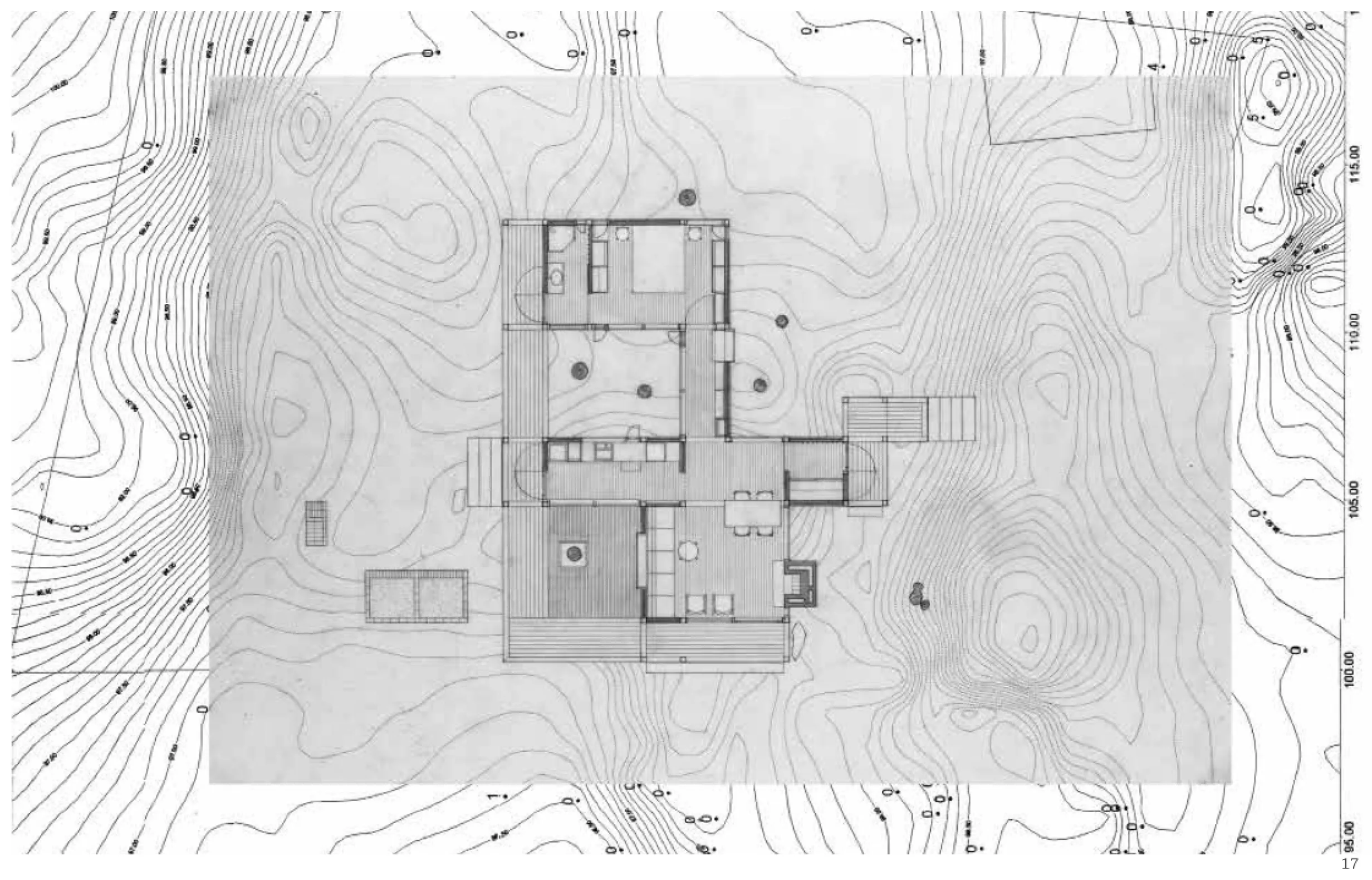
17 奈普夏屋,1997年,卡尔–维戈·霍尔梅巴克/Summer House Nipe, 1997, Carl-viggo Hølmebakk AS(摄影/Photo: Courtesy of the architect)
A frequently reproduced image of Norwegian architecture tends to link aptitude to geo-political borders, reducing its capacity to a culturalist perspective. Instead, we regard the development of a Norwegian architecture culture throughout the twentieth century to be kin to core themes in European architectural mode¬rnism at the time. When "nature" emerges as a core focus, it is due to its frequent reappearance as a thematic both in the "production of tradition" and the "tradition of production" described above. In terms of the latter, two topics emerge as imperative: The concept of "custom" and customization in architectural culture, and the significance of techniques and technology in architectural production. The latter links "nature" to the use and exploration of materials: Historical examples include Knut Knutsen's villa Natvig (Fig. 18), that explores wood tectonics on an aesthetic level, while recently, Brendeland & Kristoffersen's implement new techniques (massive wood elements) that become both architecturally absorbed and exposed in "Svartlamoen Housing" (Fig. 19). Tectonics also defines form when nature demands it: Anne Brit and Eilif Børve's project "Fuglenesdalen" from the 1990s combines a sensible architecture with architectural sensibility. The blurring of climatic intentions and climatic aesthetics is also apparent in jarmund/vigsnæs Architects' Svalbard Research Center (Fig. 20). The building synthesizes both technique and tradition with a playful languageof form, which links tectonics to customs and the customized: The idea of a unique architecture adapted to fulfll specifc demands of a specifc site.
第二大主题“自然之道”旨在描述将自然作为建筑合理化背景的项目。在这里,自然是投射建筑意象的巨大银幕。独立的建筑在景观的优美故事中得到了升华。其中一例就是莉丝贝特·丰克 (Lisbeth Funck)和托马斯·麦奎兰(Thomas McQuillan)的埃尔夫(Erve)夏屋(图12)。在林木的簇拥之下,它的方盒子造型显得小巧而朴素;而选址和朝向又让它的视野宽广而开阔。此类项目的另一个例子是比亚特·莫尔(Bjart Mohr)1973年的霍尔姆斯布(Holmsbu)画廊(图13)。宽大的窗口将森林下层的景色框成画廊的作品。还有坚持探索室内外关系的延森与斯科温建筑师事务所的莫滕斯鲁德(Mortensrud)教堂(图14),将基岩作为宗教建筑的祭坛,实现了从文克·塞尔默的谦逊形象到挪威冰川岩式的建筑配景的转变。在延森与斯科温最近的项目斯图尔峡湾小屋中,以裸露的基岩联系的室内外辨证关系被彻底抛弃。早期的崇高自然在这里成为建筑的内在特征。最终,宏大的建筑成果在设计上充分利用了周围的群山。
第三大主题“自然之象”将自然作为通过理念、幻想和叙事呈现建筑意象的概念平台。它可以是数字或模拟式的,但在对自然超越建筑和空间框架的探索和阐释上具有相同的特质。奥斯陆工作室的“誊写自然”(图15)是一个以数字手段表达建筑空间的像素化景观。他们的空间研究受到了人体与自然景观之间关系的启发,而这在他们最近的作品诺德霍夫(Norderhov)小屋中也有所体现。另一个在建筑实体与建筑表现之中发挥自然想象的例子是卡尔-维戈·霍尔梅巴克(Carl-Viggo Hølmebakk)的奈普(Nipe)夏屋(图16、17)。动工前的地形勘察结果已融入设计图纸之中。它通过5cm的高架栏表达出超越建筑实体和法定边界的地形效果。这不仅印证了因地制宜景观的重要性,也体现出将景观的故事与建筑实体相结合的意愿。

18 纳特维格别墅,1946年,克努特·克努森/villa Natvig, 1946, Knut Knutsen(摄影/Photo: Teigens Fotoatelier)19 斯瓦托拉蒙住宅,2005年,布伦德兰德和克里斯托弗森建筑事务所/Svartlamoen Housing, 2005, Brendeland & Kristofersen Arkitekter AS(摄影/Photo: Ivan Brodey)
传统的可能性

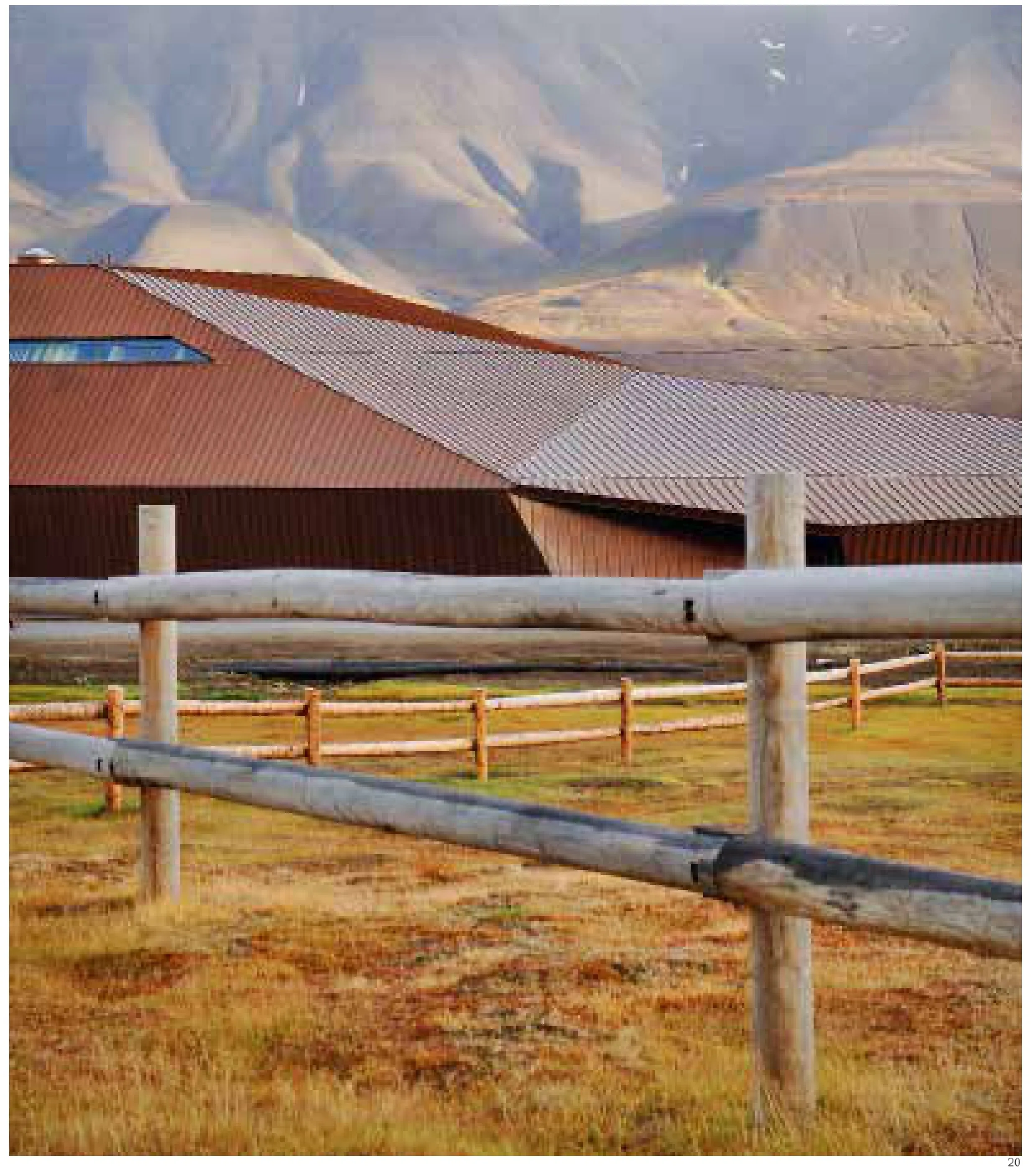
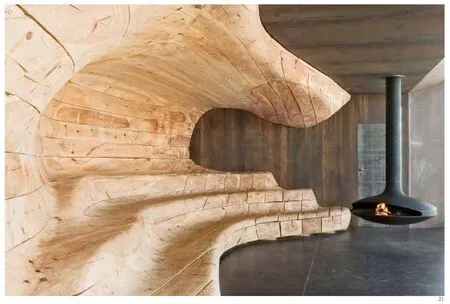
20 斯瓦尔巴研究中心,1997年,雅蒙德&维斯奈斯建筑事务所/Svalbard Administration Building, 1997, jarmund & vigsnæs Arkitekter AS(摄影/Photo: Nils Petter Dale)21 耶尔欣野生驯鹿馆,2011年,斯诺赫塔事务所/Hjerkinn Wild Reindeer Pavilion, 2011, Snøhetta AS(摄影/Photo: Ketil jacobsen)
人们常见的挪威建筑形象会把天然地形与地理政治边界联系在一起,从而影响了文化主义的视角。相反,我们认为,挪威建筑文化在20世纪的发展与当时欧洲建筑的现代主义核心有关系。当“自然”成为焦点时,这是因为它频繁出现在上文的“传统的制造”和“制造的传统”主题中。对于后者而言,有两个论点是不可或缺的:“定制”的概念与建筑文化中的定制,以及建筑制造中工艺和技术的涵义。后者将“自然”与材料的使用和试验联系起来。历史上的实例有从美学层面上探索木构造的克努特·克努森的纳特维格(Natvig)别墅(图18)。最近,布伦德兰德和克里斯托弗森(Brendeland & Kristoffersen)的新工艺(大型木构件)在斯瓦托拉蒙(Svartlamoen)住宅(图19)中,既能与建筑融为一体,又能相得益彰。构造在自然需要的时候赋予了形式。安妮·布里(Anne Brit)和艾利夫·博尔弗(Eilif Børve)在1990年代的项目“Fuglenesdalen”将建筑感融入理性的建筑之中。气候意向与气候审美的结合也体现在雅蒙德与维斯奈斯建筑师事务所(Jarmund & Vigsnæs Arkitekter)的斯瓦尔巴(Svalbard)事务所研究中心(图20)上。这座建筑以戏谑的形式语言将技术与传统组合起来,在构造与风俗和订制之间形成关联:让一座独一无二的建筑实现特定场地的具体需求。
A related narrative is found in Snøhetta]s Wild Reindeer Pavilion (Fig. 21), which quotes the nature-relation of a mountain lodge through its central fireplace and reinterpretation of traditional woodwork crafts. In Haga Grov Architects' unpretentious structure for Svandalsfossen (Fig. 22), the only iconography present is the nature-site itself. Both projects are product of the Norwegian road authority's investments in nature experiences through small architectural interventions along popular tourist routes in Norway. The limited scales and budgets of these projects are counterweighted by the architectural freedom provided, often leading to structures that either frame nature through architecture, or eradicate the relation between architectural object and landscape-context altogether.
Nonetheless, such structures constitute a minor part of the country's architectural production. Most projects occur in urban areas within juridical and economical frameworks that seldom allow for nature contemplations. As a storyline however, naturereferences are more present than ever, not the least because of the focus on sustainability within the discipline. However, architectural ontologies of nature continues to seduce and inspire architects outside the pragmatic borders of utilization value: In Carl viggo Hølmebakk's illustration for the "vøringsfossen Tourist route" (Fig. 23), the context and the content of its architecture becomes indistinguishable. Here, nature simultaneously is an architectural function and an architectural fction, in an image that both refer back in time and to possible futures of architecture. □
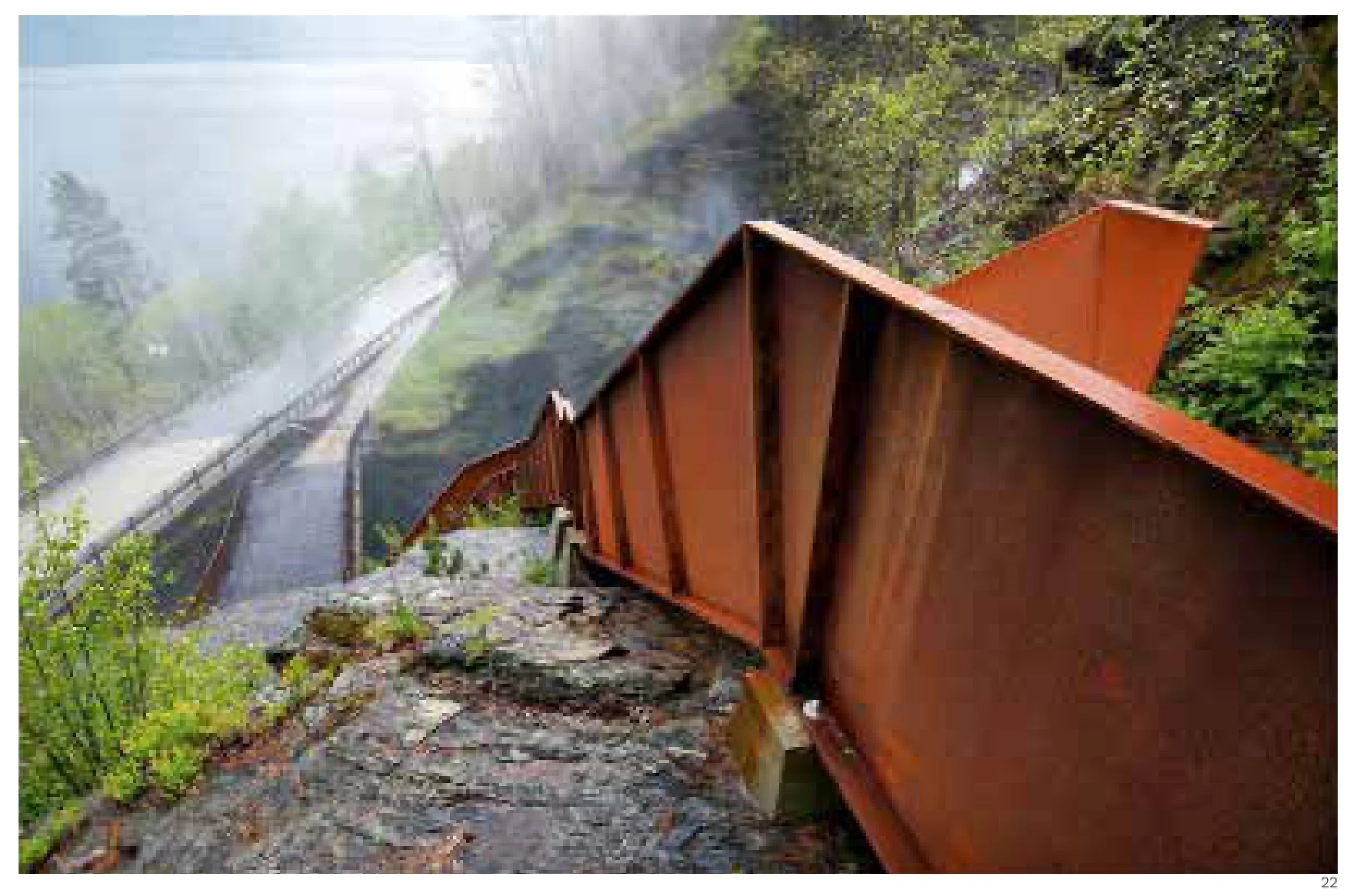
22 斯万达尔瀑布国家旅游线路,2005年,哈加和格罗弗事务所/Svandalsfossen National Tourist Road, 2005, Haga & Grov Sivilarkitekter AS/Helge, Schelderup(摄影/Photo: Rickard Riesenfeld)23 沃灵瀑布国家旅游线路,2008年,卡尔–维戈·霍尔梅巴克/ vøringsfossen National Tourist Road, 2008, Carl-viggo Hølmebakk AS (制图/Illustration: Anders Holmer)
还有一个相关的故事可以从斯诺赫塔事务所(Snøhetta)的野生驯鹿馆(图21)中看到。它通过中心壁炉和传统木工艺的新阐释,折射出山间小屋与自然的关系。在哈加与格罗弗建筑师事务所(Haga & Grov Sivilarkitekter)具有真实建筑表达的斯万达尔瀑布(Svandalsfossen)步道(图22)上,惟一的图式就是自然本身。这两个项目都是挪威道路管理局在挪威热门旅游线上以小型建筑引导自然体验的产物。项目有限的尺度和预算丝毫没有妨碍建筑的自由表达——不是以建筑作为自然框景的手段,就是摒弃了建筑实体与景观之间的关系。
尽管如此,这种建筑仍是挪威建筑制造的一小部分。大多数项目都在城区的法律和经济框架中,很少有思考自然的空间。不过,作为故事的主线,对自然的借鉴要胜过以往;而这不只是因为业内对可持续性的关注。然而,自然的建筑语汇依然在引诱和激励着建筑师走出实用价值的局限。在卡尔-维戈·霍尔梅巴克的沃灵瀑布(Voringsfossen)旅游线项目效果图(图23)中,建筑的环境与本体是不可分割的。在这里,自然既是一种建筑功能,又是一种建筑幻想,是回溯过去和指向未来的建筑意象。□
Custom Made: Naturalizing Tradition
This essay examines the notion of "nature" in Norwegian architecture. roughout the 20th century, forms of environmental awareness have manifested themselves in the built environment and architectural theory. Today, the utilization, interpretation and understanding of nature as a concept embedded in Norwegian architectural production has an almost mythical status among the country's architectural community. In the context of this Norwegian discourse, "nature" as it relates to architecture can be "decrypted" into three main themes: "nature found", "nature instrumentalized" and "nature imagined." ese terms are discussed in relation to specifc examples in contemporary Norwegian architecture.
nature, context, Norwegian architecture
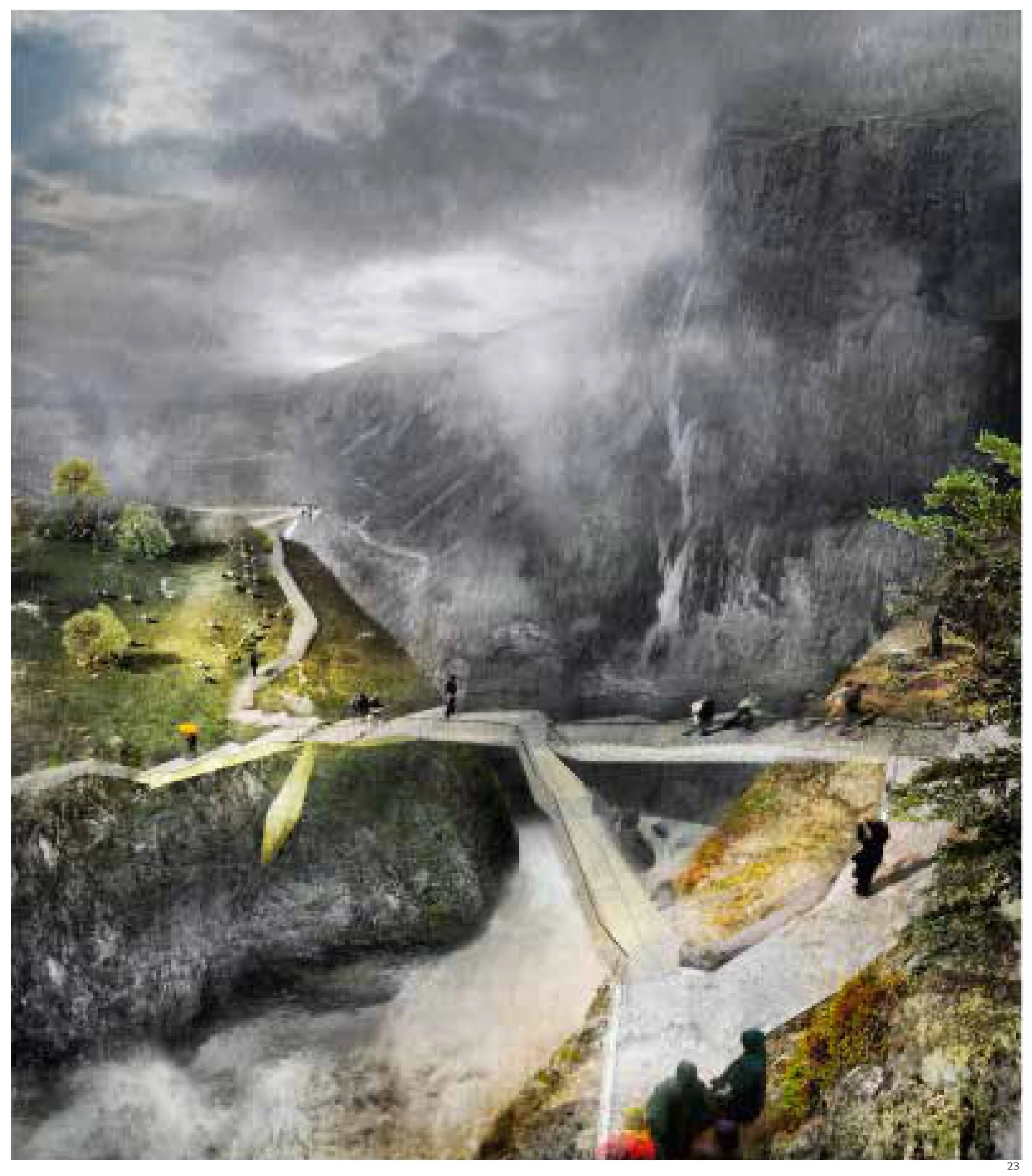
哈尔沃·魏德·埃勒夫森,建筑师。米尔扎·穆叶齐诺维奇,建筑师,MALARCHITECTURE事务所主持人。他们二人目前均为奥斯陆建筑与艺术学院在读博士生及助理教授,奥斯陆“定制”建筑展策展人,同时也是本期《世界建筑》专辑的客座编辑。
2014-03-15

